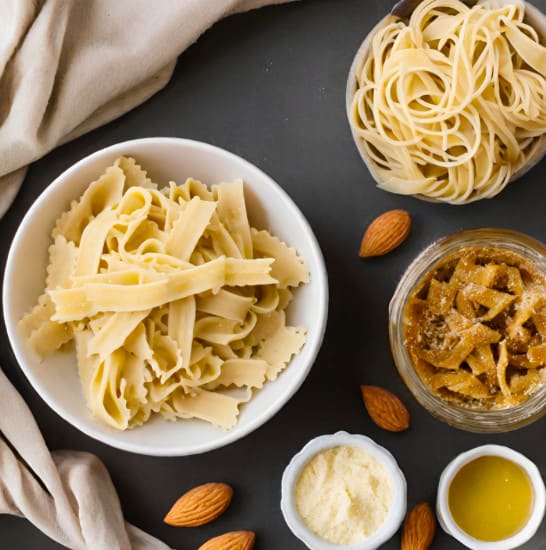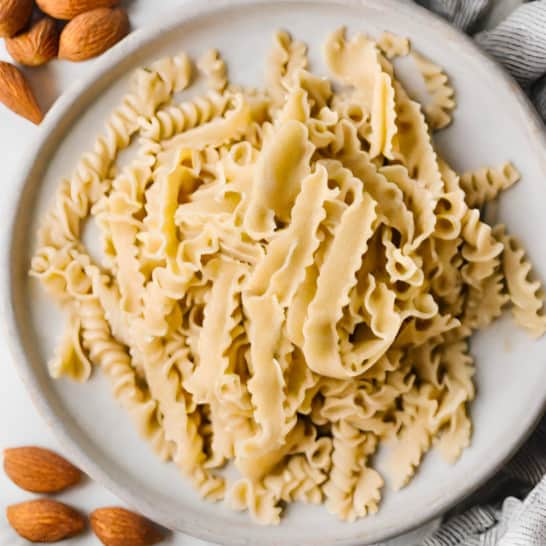
According to an expert, “Gluten free almond flour pasta is a healthy alternative to traditional wheat-based pasta, perfect for those with gluten sensitivities or dietary restrictions.” (1)
If you’re looking for a delicious pasta option that won’t leave you feeling bloated or sluggish, keep reading to discover the benefits of gluten free almond flour pasta and how it can enhance your culinary experience.

KEY TAKEAWAY
What are the basic ingredients needed to make gluten free almond flour pasta at home?
The basic ingredients needed to make gluten free almond flour pasta at home include almond flour, eggs, tapioca starch or arrowroot powder, and xanthan gum. With just these few pantry staples, along with salt, homemade gluten free almond flour pasta can be easily made from scratch in under 30 minutes.
How To Make Light & Flavorful Almond Flour Pasta in Under 30 Minutes
Making almond flour pasta at home only takes a few basic ingredients and half an hour — less time than waiting for store-bought pasta to cook! In a large bowl, combine 1 1⁄2 cups almond flour, 1⁄4 cup tapioca starch or arrowroot, 1⁄2 tsp xanthan gum and 1⁄4 tsp salt. Whisk then stir in 2 large eggs until a dough forms. Knead briefly on a floured surface then roll thin.
Cut or shape noodles and lay flat on a baking sheet. Let dry for 30 mins before cooking. To cook, boil water in a large pot then cook pasta for 1-2 mins until al dente. Drain and enjoy with your favorite sauce! You’ll be amazed at how quickly you can have fresh, low-carb pasta on the table using just almonds and a few other simple ingredients.
Tips for Creating Different Shapes and Textures with Almond Flour Noodles
Get creative with almond flour pasta! For thicker noodles, cut dough into strips with a pizza cutter. Use a pasta roller or rolling pin to make lasagna-style sheets. For fun shapes, try rolling dough into balls then flattening with a fork for cavatappi. Experiment pressing dough through a colander for tube-shape shells too. Varying textures keeps things interesting.
The Best Fillings and Sauces to Enjoy with Homemade Almond Pasta
Almond pasta goes with any pasta sauce , but light olive oil or pesto pair nicely to highlight its neutral flavor. Or mix pesto into the dough! Chicken Alfredo, veggie marinara and creamy mushroom are also crowd favorites. For filled pasta , stuff shells with ricotta, spinach and parmesan or make lasagna with almond sheets layered with meat sauce, cheese and herbs. Endless opportunities for family-friendly pasta recipes!
Is Almond Pasta Really Low in Calories and Carbs? A Nutrition Deep Dive
With only 3g net carbs per serving, almond flour pasta is a stellar low-carboption. A 1/2 cup serving contains 108 calories, 4g protein and 10g fat. Replacing wheat with almonds provides healthy fats and fewer carbs, making this a satisfying keto swap. Use my pasta in place of traditional types for all your favorite recipes while staying within macros. No need to miss out just because you’re watching carbs!
Common Mistakes to Avoid When Cooking with Almond Flour
New to almond flour? Don’t get discouraged if your first attempts aren’t perfect. Many make the mistake of under-mixing the dough, causing it to fall apart when cooked. Be sure to knead thoroughly to develop the gluten-like structure. It also helps to use blanched almond flour for its fine texture. And always add xanthan gum to bind ingredients. With practice, you’ll get the hang of working with this versatile gluten-free flour.
The Secret to Creating a Sturdy, Toothsome Bite with Almond Noodles

The key to chewy yet tender almond pasta is proper drying and cooking times. Once cut, lay noodles flat and allow to dry for 45 minutes to 1 hour, flitting them periodically. This lets the xanthan gum do its binding work. When boiling, stir occasionally so noodles don’t stick together. Undercooking will result in mushy pasta, while overcooking makes it brittle. With the right timing, you’ll nail that perfect al dente texture!
Almond Flour Pasta for Busy Weeknights: Simple Hacks and Shortcuts
Who has time to make pasta from scratch every night? Make a double batch of dough then freeze flattened balls on a baking sheet. Once firm, store in a bag for fast meals. Or prep ahead by rolling out dough, slicing into noodles, and dehydrating 8-12 hours. Simply rehydrate in boiling water for 5 minutes to revive. For true ease, keep SunButter brand keto lasagna noodles on hand as an anytime option. With alternatives like these, homemade gluten free pasta has never been simpler!
Conclusion
Gluten-free almond flour pasta is a game-changer for those seeking a healthier and more enjoyable alternative to traditional wheat pasta. Almond flour pasta is packed with nutrients, including protein, fiber, and healthy fats. Its low glycemic index also makes it an excellent choice for those watching their blood sugar levels.
Incorporating this pasta into your diet can provide a delicious and nutritious way to enjoy your favorite pasta dishes. Give it a try and share your experience in the comments below!
Frequently Asked Questions
How do I know which brands of almond flour pasta are reliable?
There are several good brands of packaged gluten-free almond flour pasta available both in stores and online. Some top brands include Banza, Jovial Foods, Anthropic and Indie Pasta Co. Reading reviews can help you determine which products have tastes and textures most similar to traditional pasta. When shopping, check the ingredients to ensure the pasta contains only almond flour and any binders or starches needed.
What can I use besides a rolling pin to roll out almond flour pasta dough?
While a rolling pin allows for even thin sheets of dough, you can also carefully use a wine bottle, aluminum can, or sturdy glass to roll between if you don’t have a rolling pin. (2) A pasta machine is best for consistently thin noodles, but not necessary – with practice rolling by hand works just fine too. A well-floured pizza cutter also makes neat, even cuts instead of a knife.
How do I add more protein to homemade almond flour pasta?
Some ways to boost the protein in almond flour pasta include mixing in a Tablespoon of whey, pea or hemp protein powder per batch of dough. You can also replace up to 1/4 cup of the almond flour with chickpea flour or soy flour. Additional eggs also increase protein without affecting the texture. Topping pasta with beans, lentils, chicken or salmon amplifies the protein further.
My almond flour pasta dough is too wet or dry. What did I do wrong?
The dough consistency is tricky to get just right. If too wet and sticky, add a tablespoon or two more almond flour. If dry and crumbly, add 1-2 teaspoons water or olive oil and knead it in. Take note of humidity levels and weigh or measure ingredients accurately next time for a flawless pasta dough.
How much time does it take to make almond flour pasta?
Almond flour pasta only requires around 30 minutes to prepare from start to finish. The stirring and kneading of the dough takes about 5-10 minutes. Then 20 more minutes are needed to roll, cut or shape the noodles and allow them to dry before cooking. Cooking time is fast at 1-2 minutes.
Can olive oil or other liquids be used instead of eggs?
While olive oil or dairy alternatives could potentially work, eggs are best for creating the structure needed in gluten-free pasta dough. Eggs bind the ingredients together and allow the noodles to hold their shape when cooked. You can try replacing one egg with 2 tbsp olive oil but flavor and texture may be compromised.
How do almond flour noodles compare to traditional egg noodles?
In texture, almond flour pasta may not be as springy or delicate as wheat-based egg noodles. It has a subtle nutty taste unlike wheat. However, it has a similar cooking time and can be shaped into similar styles like long strands or sheets. Both work well with most pasta sauces and bakes.
What is the total preparation and cooking time?
From start to enjoying a finished bowl of almond flour pasta is approximately 30-40 minutes total time. This includes 10-15 minutes to mix and roll the dough, a 30 minute drying time, then just 1-2 minutes to cook the noodles until al dente. It comes together quicker than expected for a from-scratch pasta.
Can almond flour pasta be made dairy-free or grain-free?
Yes, almond flour pasta is naturally both dairy-free and grain-free since it uses only almond flour, eggs, tapioca starch/flour and seasonings. Feel free to substitute the eggs with a dairy alternative too if needed for other dietary needs.
Was this helpful?

I’m Mary R. Q. , a seasoned professional chef dedicated to elevating home cooking experiences. Through my expertise in the culinary arts, I provide practical cooking tips and insightful reviews of kitchen utensils on my blog, milkwoodrestaurant.com. As a passionate advocate for transforming everyday meals into extraordinary culinary adventures, I aim to empower home cooks with the knowledge and tools they need to create delicious and memorable dishes. I’m also an author of the book “1,001 Kitchen Tips & Tricks: Helpful Hints for Cooking, Baking, and Cleaning (1,001 Tips & Tricks)” which is sold on Amazon. Join me on a flavorful journey as we explore the art of cooking and the essential tools that make it a joy.







